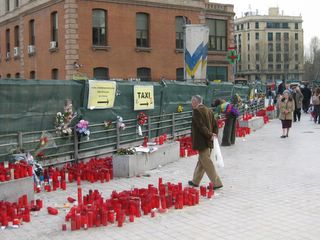The purpose of open space cannot be predefined
Last night I saw a presentation by Fred Kent, president of Project for Public Spaces, during which he talked about good and bad designs for parks and open spaces. Interestingly, the characteristics of what we as residents consider a great park is often at odds with those parks that win design awards by landscape architects who judge these things. Importantly, what makes a park or more generally open space great is that people use it. What people will use a space for cannot be known ahead of time.
 While in Madrid in March 2004, a few weeks following the horrible terrorist bombing of the Madrid train station, a wide sidewalk became a spontaneous memorial to those who lost their lives in the attack. No planner could have planned for this area to be used as a memorial, but the existance of space allows people to make use of it as their needs change. This memorial affected not only the people who lit candles, but hundreds of thousands of people who passed by every day. It is the unanticipated uses of open space that makes it so necessary, and equally why design is less important in the creation of space, than ensuring that a space can be used for multiple purposes.
While in Madrid in March 2004, a few weeks following the horrible terrorist bombing of the Madrid train station, a wide sidewalk became a spontaneous memorial to those who lost their lives in the attack. No planner could have planned for this area to be used as a memorial, but the existance of space allows people to make use of it as their needs change. This memorial affected not only the people who lit candles, but hundreds of thousands of people who passed by every day. It is the unanticipated uses of open space that makes it so necessary, and equally why design is less important in the creation of space, than ensuring that a space can be used for multiple purposes.
In Santa Cruz, California, wide sidewalks in the downtown provide space for outdoor eating, musicians, strolling, and a wealth of sidewalk entertainment. On any particular day, you never know who or what you're going to see and experience on the streets of Santa Cruz, and it's this aspect that brings energy to the downtown.

0 Comments:
Post a Comment
<< Home